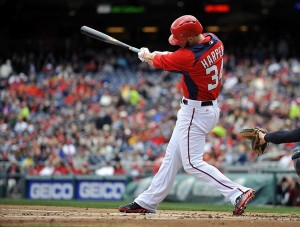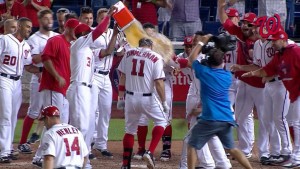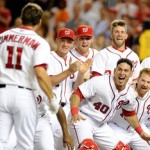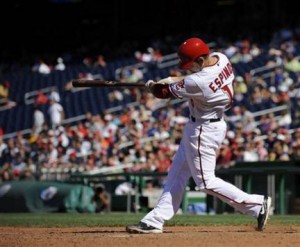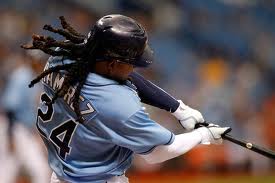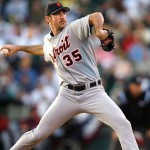
Is Virginia Native Justin Verlander the best ever player from the State? Photo unknown via rumorsandrants.com
Recently, I read a pundit who talked about how a huge percentage of baseball prospects come from relatively few states; California (mostly Southern California at that), Texas, Florida and Georgia. The Baseball America guys once talked about an “All North Carolina” team and how good it would be (BA is based in Durham, NC). It got me thinking: how good of a team could you put together of prospects with ties to Virginia? Having grown up in Virginia and having had the opportunity to play with and against a number of guys with pro ties over the years, I thought it’d be interesting to put together the “All Virginia Team.”
Using mostly the handy Baseball-reference pages, I looked up players who were either born in Virginia, went to a Virginia-based high school, or played baseball at one of Virginia’s universities. There’s also the fantastic Baseball Cube website (www.thebaseballcube.com) that has very in-depth player databases searchable by high schools that shows every player on a professional or NCAA team by school, which sometimes has better records than B-R.com. The players here had to be active in the Majors in 2012, though as it turned out there’s enough guys with Virginia ties to make a full starting team. Feedback is welcome.
Here’s a roster:
Backups: Brandon Guyer OF (HS in Herndon, college at UVA), Rich Thompson OF (college at JMU), Jeff Baker Util (HS at Garfield in Woodbridge), Brandon Snyder IB/OF (HS at Westfields in Chantilly). Erik Kratz C (college at Eastern Mennonite)
Ok, so we’re a little weak up the middle. Zimmerman played SS in college but I can’t find a legitimate shortstop out there. Rhymes was just signed by the Nats to a minor league deal and isn’t likely to make the opening day 25-man roster save for injury. Inge hasn’t caught regularly in a few years. But how about the hitting prowness of this lineup? BJ Upton-Cuddyer-Zimmerman-Wright-Justin Upton-Reynolds is a pretty powerful group. Coincidentally, I put in Kratz because I find it amazing that someone who played baseball at Eastern Mennonite is actually in the big leagues. By B-R’s records, he’s the SOLE alumni of that university to have ever even played professional baseball.
Starting Pitchers:
Backup starters: Danny Hultzen (born and raised in Bethesda, college at UVA); an exception to my “active in 2012” rule but clearly the most high-profile tied-to-Virginia prospect in the game right now. John Maine (born in Fredericksburg, HS in Stafford) had a decent stint starting for the Mets, but he’s yet to get back to the majors after a shoulder surgery in 2010).
A pretty good 1-2 punch, including arguably the best pitcher in the game. Hudson has some potential. Saunders is more of an innings eater lefty, but he’s made a pretty good career for himself already. Stauffer had elbow surgery in August 2012 and probably isn’t ready for opening day, but he’s the best I could find.
Relievers:
Backup Relievers: BJ Rosenberg (born in Newport News), Jeremy Jeffress (born and HS in South Boston), Clay Rapada (born in Portsmouth, HS in Chesapeake, college at Virginia State). Seth Greisinger (McLean and UVA) as an honorable mention.
Not bad depth here; I suppose Marshall could close, Bray be the loogy, Camp be an 8th inning guy, Eppley a 7th inning type and the rest be middle men. I like how Sean Camp was born, raised, went to high school and played baseball in college without ever leaving Fairfax.
Other random Virginia School trivia:
What’s the best producing college in Virginia? Pretty easily its UVA, with 117 pro players in B-R’s database and 30 guys reaching the majors. Virginia Tech, ODU, Richmond and VCU are all grouped a bit behind UVA in terms of pro player development. Amazingly little Liberty University has matriculated 59 players to the pro ranks.
At current, UVA has 6 active alumni in the majors. William & Mary, ODU and Richmond have 2 each, and a slew of lesser baseball-playing universities have one each (all of which are mentioned above).
What’s the best producing High School in Virginia? Pretty clearly the high schools in the Virginia Beach/Chesapeake area have been producing some serious baseball talent lately, but even the Upton brothers ended up going to different high schools. Both Virginia HS in Bristol and First Colonial HS in Virginia Beach list 8 pro player alumni with 2 pros each.
Closer to home in Northern Virginia: Garfield has 7 total players with Pro experience in the database, 3 of which have MLB experience. Robinson HS in Fairfax has 6 pros/3 MLB experience. Fairfax HS also has the same; 6 pros, 3 with MLB experience.
Of course, these numbers pale in comparison to some of the baseball factories in the major baseball-producing states Florida and California. Hillsborough HS in Tampa boasts 41 pro alumni and 10 with MLB experience, including Gary Sheffield, Dwight Gooden, Carl Everett and our own Elijah Dukes. Lakewood HS in Orange county has 57 pro alumni and 12 MLB experienced players, though not nearly of the name quality of Hillsborough’s graduates. Sarasota HS in Florida also boasts 57 pro player alumni, 14 MLB pros including our own Ian Desmond. There’s a HS in Oakland called McClymonds that has two Hall of Fame alumni (Frank Robinson and Ernie Lombardi), a host of other famous names from 60s and 70s but which hasn’t generated a pro player since the mid 1970s. Lastly Polytechnic HS in Long Beach has 47 pro alumni but an astonishing 18 guys with MLB experience, headlined by Hall of Famer Tony Gwynn and possibly future hall of famer Chase Utley.
Who is the Greatest player to have Virginia Roots? You could make arguments for Verlander, Wright, Zimmerman or the Upton brothers (probably in that order), but how about one Lou Whitaker, born in Brooklyn but somehow ended up matriculating from HS in Martinsville, Virginia, where he was drafted in the 5th round by Detroit. Billy Wagner (born in Tannersville, HS in Tazewell and college at Ferrum) is another guy from Virginia with a long, successful career. Long-time Oriole Al Bumbry was born in Fredericksburg, went to HS in King George and attended Virginia State.
However, there’s only one Hall of Famer with Virginia Roots that I can find: Eppa Rixley, born in Culpeper, HS in Charlottesville and he pitched for UVA before being signed as a free agent by Philadelphia. He ended up pitching 21 years in the majors and was selected to the Hall of Fame by the Veteran’s committee in 1963 shortly after he died.
(Post publishing note: in 2015 an enterprising blogger at the hallofverygood.com put together a list of the “best baseball player” from each of the 68 teams to make the *basketball* March Madness tournament, and for the Virginia schools he mentioned Rixley as well as others. A fun read).
(Editor’s Note: you may feel free to stop reading now; Below here is all pretty obscure stuff and only probably interesting to myself and my dad, or people who happen to grow up in the area and are familiar with Vienna baseball. In fact, I kind of got into a rat-hole of reminiscing for this section, thinking back to the good old days. I won’t be offended :-).
My Personal experiences growing up and playing in Northern Virginia: I played Vienna youth leagues from 1977 til 1989, played in Vienna Babe Ruth and graduated from James Madison HS in Vienna in 1989 for reference.
The best player from Northern Virginia in my youth experiences was one Pete Schourek, who was two years older than me and graduated from Marshall HS in 1987. An enduring memory from my youth was watching Schourek blast a home-run to the townhouses beyond the RF fence at Marshall against Mike Nielsen (the ace of my own high school) in 1987. Schourek turned down a scholarship offer to Auburn and took 2nd round bonus money from the Mets. Schourek’s career lasted 10 years in the majors and his best season was an 18-7 year that resulted in a 2nd place Cy Young finish. The word at the time was that the Dodgers wanted to draft him as a hitter; his power from the left-hand side was quite superior. I often wonder if his would have made it as a hitting prospect; he had such natural lefty power in high school. (Click here for the Connection’s Schourek profile in their “top 100 athletes” series from 2000).
Other notable pro players from the 3-4 year period right around my draft year who I played against at various points:
- A.J. Hernandez, who was the star of the local Herndon/Reston/McLean Babe Ruth all-star teams that had Vienna’s number year after year in the late 80s. He played one year of low-A ball.
- David Carroll, a tall, rangy left-hander who dominated Chantilly baseball for years. He was a 6th round pick in 1991 and made it to AAA before washing out. We played against Carroll’s teams in the Credit Union in the early 90s.
- Lonnie Goldberg, who was on the same HS team as Schourek at one point; played at George Mason, drafted in the later rounds and played 5 seasons of minor league ball.
- Bill Pulsipher, who was a dominant player in the area and was drafted in the 2nd Round by the Mets in 1991 out of Fairfax HS. He made the Mets rotation by age 21 and looked decent before getting injured and spending the rest of his MLB career struggling in the bullpen. His b-r.com page shows his drive; he was still playing professaional Indy ball as late as 2011. (Pulsipher Connection profile from 2000).
- His 1991 Fairfax HS team also had one Brian Buchanan, who was a 1st round draft pick after attending UVA and played 5 years in the majors. Imagine; one high school team with a 1st and a 2nd round draft pick in this area. Amazingly Fairfax HS didn’t win anything more than its District during this time.
- Robin Jennings: a 1990 graduate of Annandale who did a year of community college and the got drafted under the old Draft-and-Follow rules by the Cubs. He played in parts of four major league seasons spread across 12 minor league seasons, including his last minor league season with the Washington organization in 2007 at the age of 35, fully 4 years after last appearing in a uniform. I can’t specifically recall playing against Jennings like I can recall playing against these other guys though. Maybe in fall ball.
- (post-publishing edit thanks to Tom Davis in the comments): Robinson slugger Steve Dunn. He absolutely deserves to be on this list somewhere. https://en.wikipedia.org/wiki/Steve_Dunn_(1990s_first_baseman). 1988 Robinson graduate, 4th round pick by Minnesota, he played parts of two seasons in 94 and 95. The Twins released him, he played one more AAA season for Cleveland (putting up decent numbers) but either quit or was released and not picked up again.
Goldberg and Schourek, along with Marshall’s #2 pitcher Steve Makranczy led Marshall to back-to-back state championship games in the late 80s. Steve played on a number of fall teams with me and still plays in the local DCMSBL league. Schourek still suits up for teams in the Industrial League, and according to a couple of random friends, plays in an ultra-competitive basketball league along side other former Division 1 players in the area.
Speaking of my own HS of the time; I was always amazed we didn’t fare better. Thinking back to 1988, my HS started an entire team of guys who either went pro or played division 1 somewhere. The 3 leading pitchers played at Radford, BYU and GMU respectively, our starting catcher went to BYU. Our 1B played at William & Mary. Our middle infield combo both played at UVA. Our 3rd baseman was a full ride player at NC State. In the OF, one guy played at GMU and went pro, another guy played at Montgomery College. That’s a LOT of talent on one HS team for this area, and they never advanced in the Regional tournament.
The best local player of my draft year (1989) was a fellow by the name of Doug Newstrom, born in Quantico and who went to HS at W.T. Woodson in Fairfax. He went to Arizona State and was a 7th round pick after his Junior year but never made the big leagues. Newstrom was the cornerstone of a Woodson team that went undefeated in 1989 and won the state championship (they also won in 1990). My personal experience playing against Newstrom; the fall-league baseball teams of that time period were essentially city-specific all-star teams of the guys who didn’t play football, and the competition was great. The Woodson varsity team to-be in the spring of 1989 got all their guys together to get a “test run” of their team and they romped to the fall league 16-18yr old championship game. Our Vienna-based team was a rag-tag collection of guys who attended Madison, Marshall, Oakton, Paul VI and O’Connell but who had Vienna zip codes, but we were good and we also reached the championship game. It was on a cold November day at Falls Church High School. We faced off against Woodson’s ace (Mark Bauch, the same guy who would go 13-0 the following spring en route to the Virginia State championship) and promptly knocked him out in the first inning without retiring a batter, racing to a 6-0 lead. Our pitcher (Jeff Ford, who attended Oakton and played college ball at a small school somewhere) tried to keep the Woodson team at bay throughout the 7 inning game, but they fought back. In the bottom of the 7th trailing 6-5 and with two outs, the Woodson team put a couple guys on and Newstrom came to bat. Newstrom connected on a towering drive to right field; I thought he had just hit a walk-off homer. Our right fielder (Steve Paasch, another Oakton graduate) reached over the RF fence, jumped and caught the ball for the 3rd out and the championship. It was one of the two or three best games I was ever a part of.
Editor Update: my memory apparently failed me: turns out Newstrom was actually a year behind me (he was born just a few months after me but was a school year behind). He led Woodson to a 2nd consecutive VA state title in 1990 before committing to ASU. I got a nice shout-out from one Rob Paine months after this post with a link to this great feature of Newstrom, with a great photo.
Best player from my high school Alma Mater (James Madison HS in Vienna): probably one Mike Wallace, who was picked straight out of high school, was in the majors by 22, and out of the majors by 26. Wallace seems like he should have played longer; he was a lefty with decent numbers both in the majors and in his final seasons in the minors. But he was retired at 28. He signed on with MASN as a baseball pundit in 2011. However it is worth mentioning one Jay Franklin, who graduated from Madison HS in 1971 and was the 2nd overall pick in that year’s baseball draft. Its hard to imagine a DC-local kid at this point in the evolution of the draft ever going higher, so Franklin likely holds the title for “highest ever local draft pick” for the forseeable future. He tore up the Northwoods league and earned a call-up to the majors as an 18 year old. I’m guessing he got hurt though, because he missed the entire 1972 season. He appeared in four more minor league years before retiring at age 24, having just reached AAA. Another guy who seems like he should have played longer.
Editor addition: thanks to anonymous comment for reminding us about Bobby Brower, whose baseball-reference.com page is missing the fact that he went to Madison HS. He was one heck of an athlete, earning FOUR varsity letters his senior year of HS. He attended Duke University, playing both football and baseball before focusing on hardball. Despite being an All-ACC selection, he went undrafted, got picked up by Texas and eventually fought his way to the major league team. He was traded to the Yankees after a couple years with Texas but struggled for playing time in New York, getting dropped back to AAA where he stayed through 1990. A brief comeback in 1992 went for naught and Brower retired at the age of 32. And I’ll add one Ronnie Slingerman, whose name keeps popping up during research of these early JMHS teams and who remains active in the Vienna baseball community.
Btw, the Fairfax Connection news papers featured all three of these players in their “Top 100 local Athletes” series done in the year 2000. Click here for Wallace, here for Franklin and here for Brower‘s bios, all three of which go in to much greater detail than I have here.
Baseball-reference.com’s records are somewhat spotty on my high school; they list only 7 pro players and 2 major leaguers from my HS, but we know there are several more with pro experience, just counting guys I’ve directly played with (among others; Chris Burr and Billy Emerson). BaseballCube lists 28 guys in their database, though not all played pro. David Driver with The Vienna Patch did an article on Wallace in October 2012 and discussed several other Madison grads who have made the majors, some of whom are not correctly attributed in B-R.com either. One such player is Jim McNamara, who I’m familiar with because he used to substitute teach while I was attending the high school and he was famous for being manipulated into wasting an entire period talking about his baseball playing days instead of teaching any material.
Best player ever from my college Alma Mater (James Madison University): probably one Billy Sample, born and raised in Roanoke and who played at JMU from 1974-1976. He was drafted in the 10th round, played for a decade or so and hung ’em up in 1986. Mike Venafro was born in Takoma Park, went to Paul VI in Fairfax and then JMU before putting together a 7-year career in the majors, retiring back in 2006. JMU is actually a pretty decent baseball school; we’ve made the NCAA tournament 11 times and several times recently, and made the College World Series in 1983 (getting blasted by eventual champion Texas and Stanford for a 2-and-out appearance; the wikipedia page is funny, JMU has no “notable players” listed. Coincidentally; look at some of the talent playing in that tournament: Bonds, Schiraldi, Clemens, Larkin, Sabo, McDowell, Incavilia. Three future Hall of Famers). However I can only find one JMU alumni who appeared in the majors in 2012; the aforementioned Rich Thomas, who appears to be a 4th/5th outfielder.
Best player I played with or against post youth/High School: After high school we played in a local amateur league for a year, then put together an entry into the Credit Union, which was a powerful amateur league in the area (which is now part of the Industrial League). After a brief baseball hiatus spent mostly playing softball (there was no 19+ league in DCMSBL at the time; you had to be at least 30 to play in the league for many years), I’ve been playing consistently in the DCMSBL since 1998.
In the early 90s, we had a local guy named Kevin Gallaher pitch for us periodically. He had Vienna roots, went to O’Connell and then played at St. Bonaventure (none of which btw is on his baseball-reference page but is on his baseball Cube page). I got to catch Gallaher here and there and he had pretty good stuff. Apparently his stuff got better his senior year at college and he was a non-drafted FA signee. Gallaher made it to AAA before calling it quits at age 29. His next move: to appear on the reality TV show “Married by America” (it didn’t work out: his bride-to-be left him at the alter).
In the Credit Union, we played against some serious talent, but I was too young to remember most of them. A couple notable names that I do remember were Steve Norwood, brother of the infamous Buffalo Bills kicker Jeff Norwood, who played alongside his father Del Norwood on the Apple team. Norwood was a local legend, a longtime coach at W&L in Arlington (he won 10 straight district titles in the 60s and 14 overall at the school; the field is named after him) and had to be in his 70s at the time but could still throw a knuckle-ball by the semi-pro calibre players of the Credit Union. Local legend amateur player Pete Groves pitched against us in the league; he now leads the Fedlock teams that have won many national MSBL titles (he supposedly reached AAA but I can’t find any records of him playing pro). We picked up a random guy off a wait list named John Bonfield who had pitched at Yale; he was one of the better pitchers i’ve ever played along side. He could throw 8 different pitches but had a failing for “enforcing the unwritten rules of the game” at the most unideal time. He once purposely hit a guy who he thought was stealing signs with the bases loaded in a close game.
In MSBL, the best players I played against didn’t necessarily have direct professional ties. The Gouveia siblings (brothers of former Redskin Kurt Gouveia were feared sluggers in the league). Garland Cooper was competitive against players half his age; he played in the Valley league but never pro. Ira Holland (who played college at Howard and was drafted before returning to school) was probably the most feared hitter in the league in the early 2000s; guys from that era still ask us about him. The ace pitcher of my current team Jason Martino signed out of HS but only played one year of rookie ball before getting set aside by his drafting team.
Anyway; if you’ve read this far, I hope you enjoyed my own little personal history of playing ball in this area.
